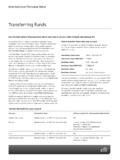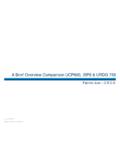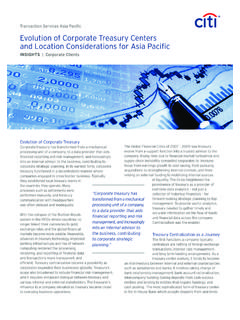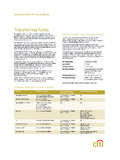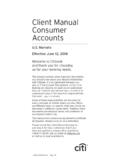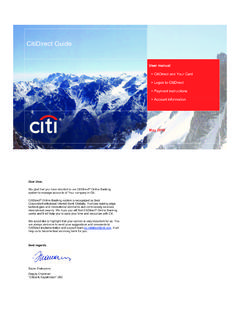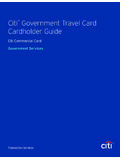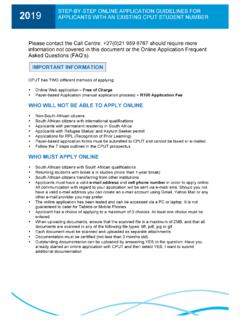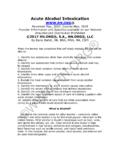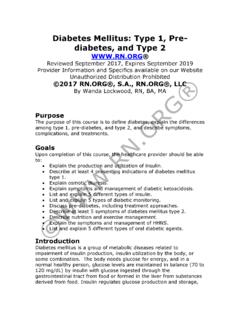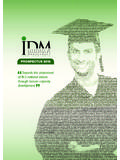Transcription of PowerPoint-Präsentation - Citibank
1 Basel III and Deposits Edith Rigler, Market Policy Expert, Transaction Banking Academy Diane Drinnon, Global Product Head for Investments and Deposits, Citi Treasury and Trade Solutions Citi Transaction Banking Academy for Financial Institutions Professionals | 4 June 2014 Citi Treasury and Trade Solutions Today s Speakers Diane Drinnon Global Product Head for Investments and Deposits Citi Treasury and Trade Solutions Edith Rigler Market Policy Expert and Tutor Transaction Banking Academy Moderator Mike Hewitt, Transaction Banking Academy 1 Transaction Banking Academy is the leading global provider of professional training for the transaction banking sector Its tutors are acknowledged experts with recent, real-world experience of transaction banking and treasury The academy offers a wide range of standard courses covering most aspects of transaction banking Custom courses can quickly be developed for specific bank requirements Training can be delivered on-site or through webinars like this one Enquire through citi to receive a discount on custom training programs.
2 More information at 2 Table of Contents to Basel III New Liquidity Standard for Banks - and Responses Solutions and Answers 1. Introduction to Basel III Some Background on Basel III Basel III is an agreement among supervisors, not a regulation itself No global enforcement body exists Each country determines how rules apply in their own jurisdiction Yet there is strong pressure to implement Basel III homogeneously Broad principles have been worked out Some finer points are yet to be decided Basel III is a comprehensive package of financial regulation.
3 3 Basel III Will Make Banks Less Likely to Fail Basel III increases capital requirements and introduces a global liquidity standard. Increases capital requirements Introduces liquidity standard 4 Basel III Raises Capital Requirements Strengthens definition of capital Increases minimum risk-weighted capital requirement from 2% to Adds capital conservation buffer ( ) Adds systemic surcharge for Global Systemically Important Banks Increases requirements for trading book Introduces leverage ratio as backstop 5 Basel III Introduces a Global Liquidity Standard liquidity risk liquidity risk a)Hold buffer against short-term outflows (Liquidity Coverage Ratio) b)
4 Avoid short-term wholesale funding (Net Stable Funding Ratio) Essentially, there are two main elements to the liquidity standard. 6 2. The New Liquidity Standard The New Liquidity Standard Measurement Establish contractual maturities for assets and liabilities Adjust contractual schedule to reflect expected outflows and inflows under stress Result is net expected outflow over each time period Focus is on net outflow over next 30 days Mitigation Liquidity Coverage Ratio (LCR): banks will be required to hold buffer of liquid assets equal to 100% of net short term outflow Net Stable Funding Ratio (NSFR).
5 Banks will be required to limit the reliance that they can place on short-term wholesale non-operational funding The new liquidity standard measures and mitigates liquidity risk. 7 Measuring Liquidity Risk (1) Is funding repayable or callable within 30 days? 0% No Outflow factor Longer-term (more than 30 days) liabilities do not pose significant liquidity risks. No liquidity risk since there can be no outflow within 30 days 8 Operational vs. Non-operational Deposits Operational Deposits Include general working capital and cash held by depositors for transactional purposes Basel III considers operational cash to be stickier than non-operational cash, in the sense that companies are likely to maintain operational deposits with their primary transaction bank(s)
6 Bank has to hold liquid assets equal to 25% of operational deposits Non-Operational Deposits Include other cash balances not immediately required by the depositor s business More likely to be used to chase yield and to manage counterparty risk via the diversification of investment Susceptible to run, if credit rating of the bank taking the deposit deteriorates Bank has to hold liquid assets equal to 40% of non-operational deposits Banks are required to distinguish between two types of short-term deposits. 9 Measuring Liquidity Risk (2) Is funding repayable or callable within 30 days?
7 Is deposit an operational deposit? 25% Yes Yes Outflow factor Operational deposits are sticky and likely to be rolled over at maturity. Operational deposits include cash held by depositors for transactional purposes in cash management or custody accounts 10 Measuring Liquidity Risk (3) Is funding repayable or callable within 30 days? Is deposit an operational deposit? 40% Yes No Outflow factor Non-operational short-term wholesale funding poses the most liquidity risk. Non-operational accounts are risk-sensitive; depositors are likely to run if bank s credit rating deteriorates 11 Measuring Liquidity Risk Summary Is funding repayable or callable within 30 days?
8 Is deposit an operational deposit? 40% Yes Yes Outflow factor Overall, liquidity risk depends on maturity and type of liabilities. No 25% 0% No 12 Expected outflow over next 30 days Expected inflow over next 30 days Net outflow LCR 100% buffer against net short-term outflow The LCR requires banks to hold a buffer against net short-term outflows under stress. Basel: A bank must notify its regulator immediately if its LCR has fallen, or is expected to fall below100% US: If a bank s LCR is < 100% for three consecutive business days, the banking organization must submit a liquidity compliance plan The Liquidity Coverage Ratio 13 Both US and EU Have Accelerated Implementation of LCR 0% 20% 40% 60% 80% 100% 120% 1-Jan-15 1-Jan-16 1-Jan-17 1-Jan-18 1-Jan-19 Liquidity coverage ratio implementation schedule Basel EU US The US starts higher than the EU and finishes earlier.
9 14 The Net Stable Funding Ratio Stable long-term funding Long-term Short-term Short-term unstable (wholesale) funding financing long-term assets NSFR limits this amount Assets Liabilities The Net Stable Funding Ratio The NSFR limits the reliance on short-term unstable wholesale funding. The NSFR will be introduced as a minimum standard from 1 January 2018 Short-term liabilities matching short-term assets 15 The Net Stable Funding Ratio Mitigates Key Risk The NSFR complements the LCR but has a separate objective: it requires banks to maintain a sound funding structure It is defined as the amount of available stable funding relative to the amount of required stable funding.
10 This ratio should be equal to at least 100% on an on-going basis Its time horizon extends to one year The NSFR consists primarily of internationally agreed upon definitions and calibrations. Some elements, however, remain subject to national discretion to reflect jurisdiction-specific conditions The minimum requirement is to be implemented from 1 January 2018; until then, an observation period is in place and some revisions to the NSFR might take place The NSFR must be reported no less than quarterly. However, supervisors can authorize a lower reporting frequency on the basis of the individual situation of particular bank The NSFR is one of the Basel Committee s key reforms to promote a more resilient banking sector.

